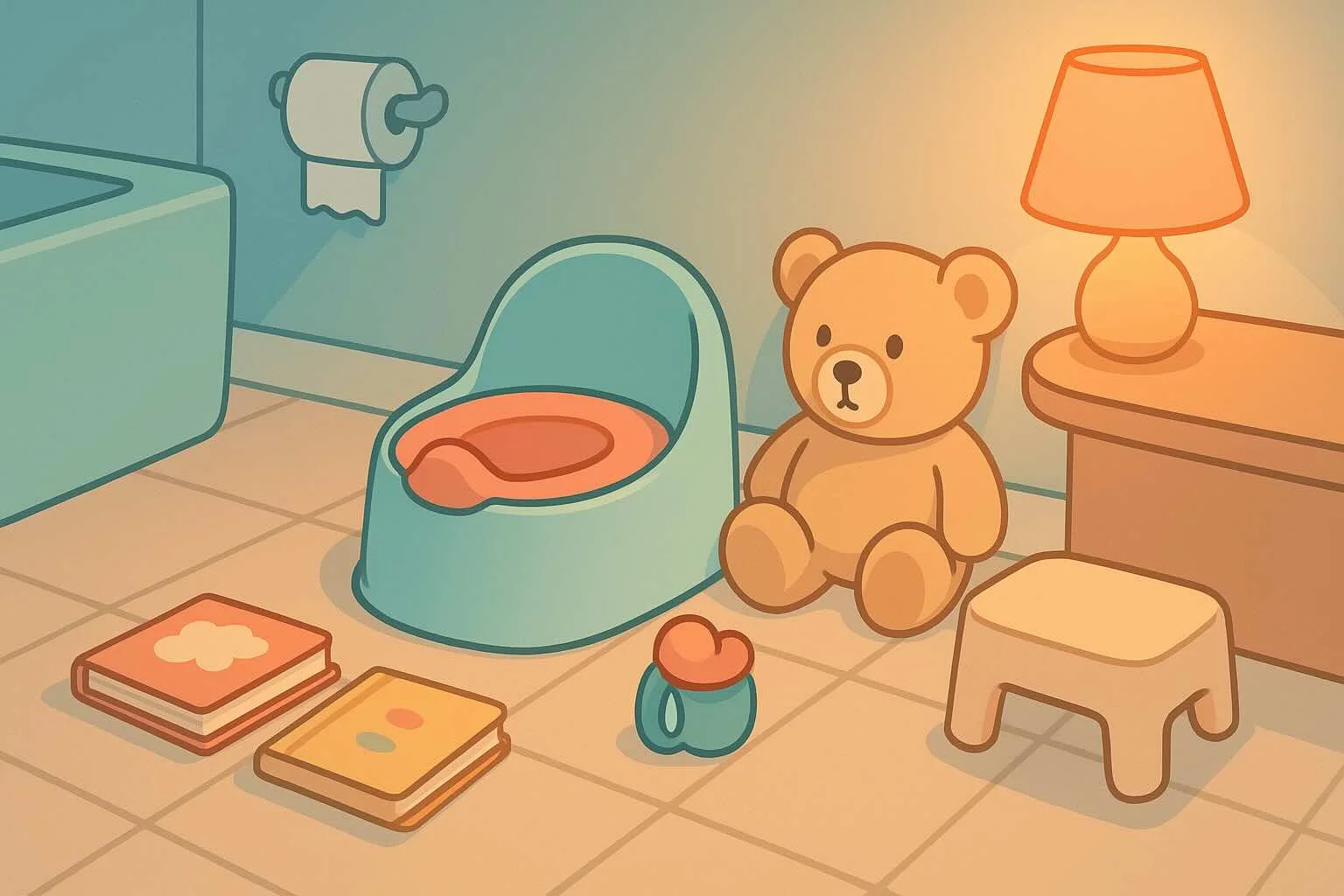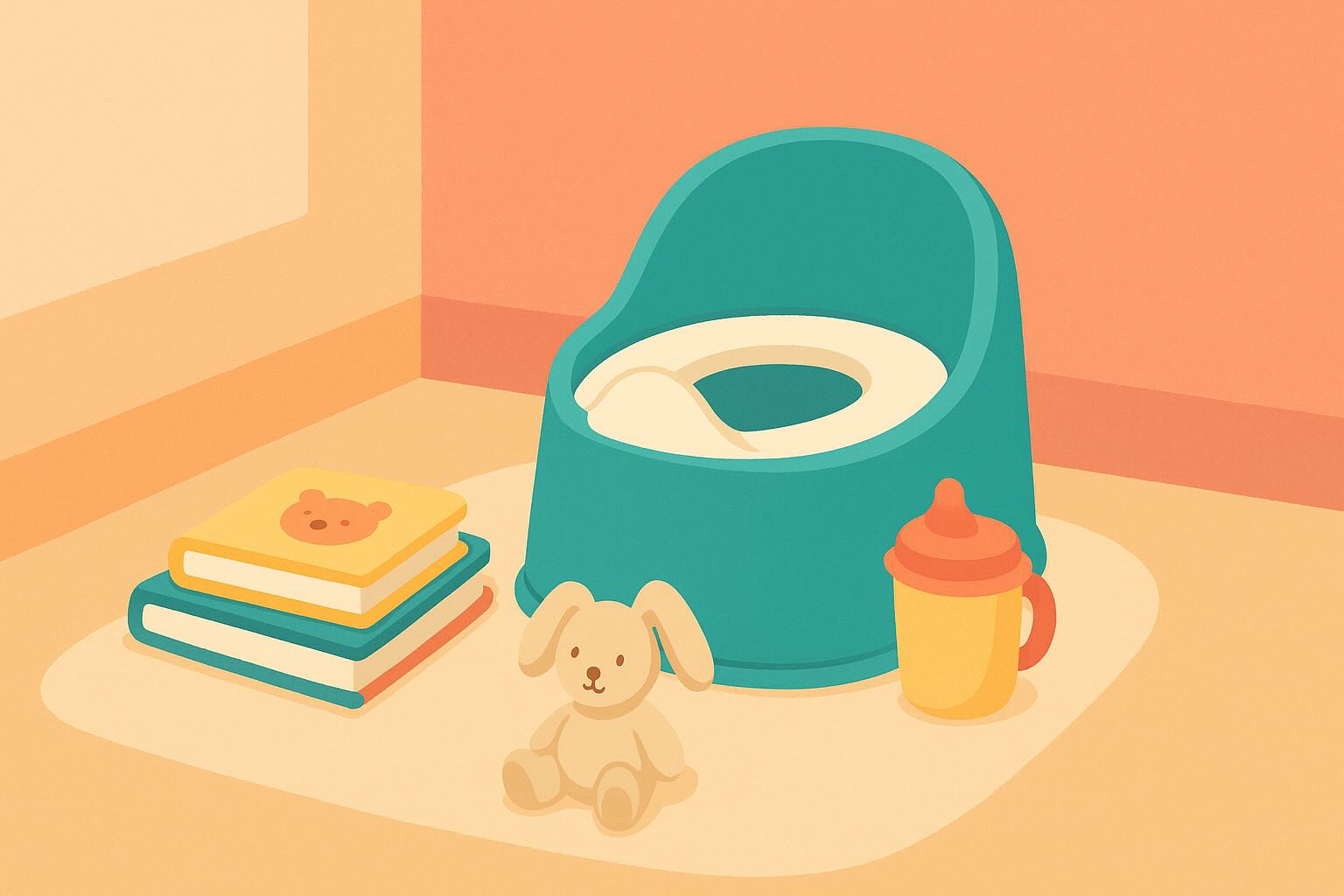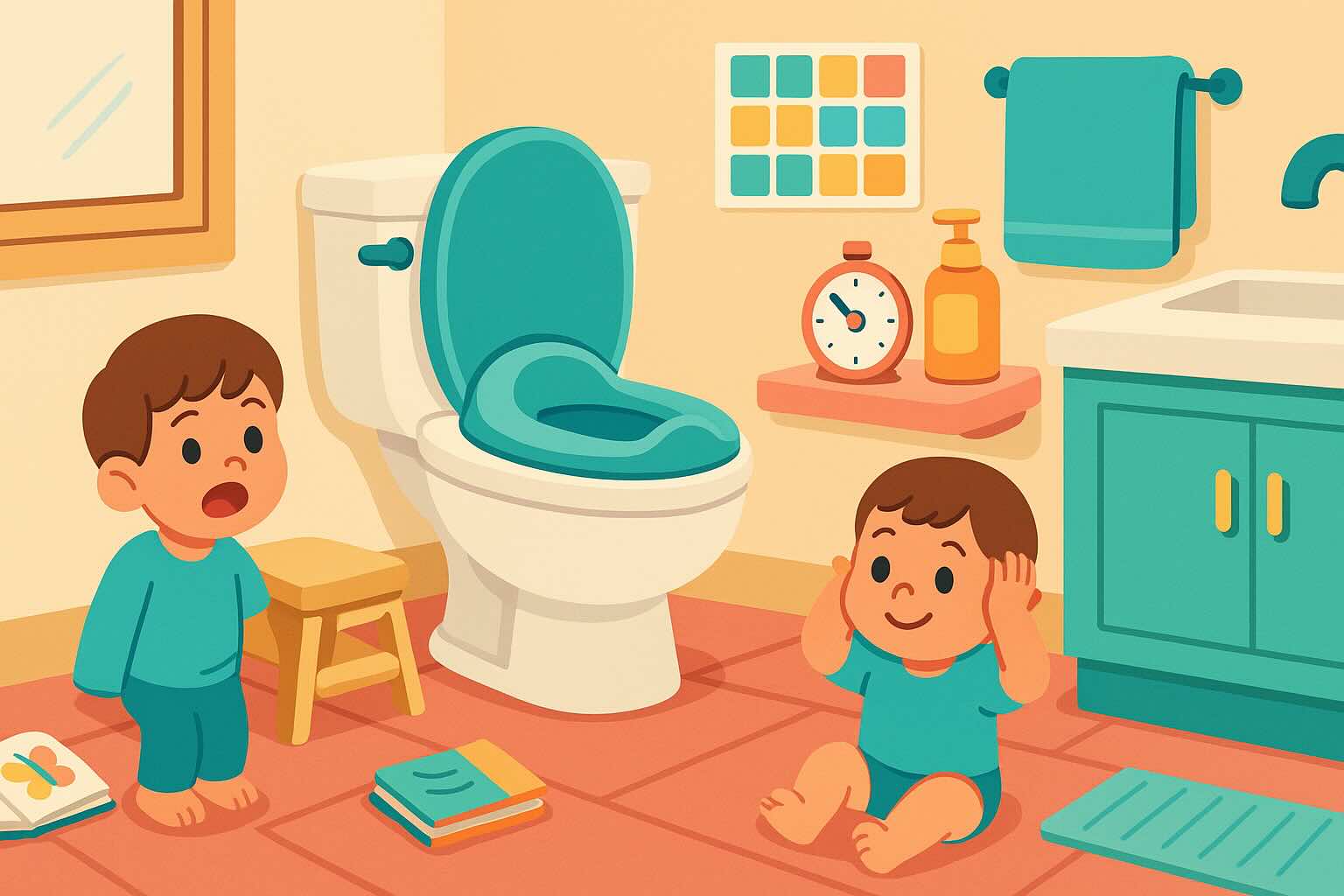Potty Training While Traveling: Should You Pause or Continue?
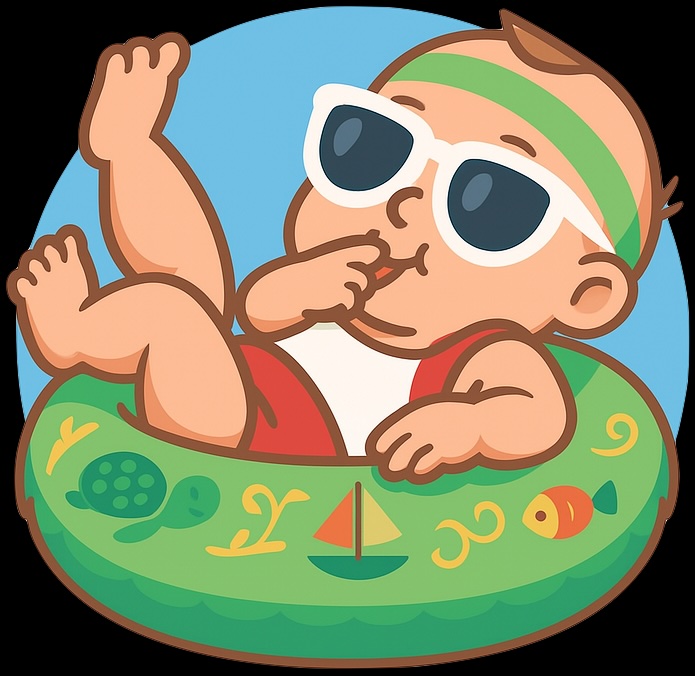
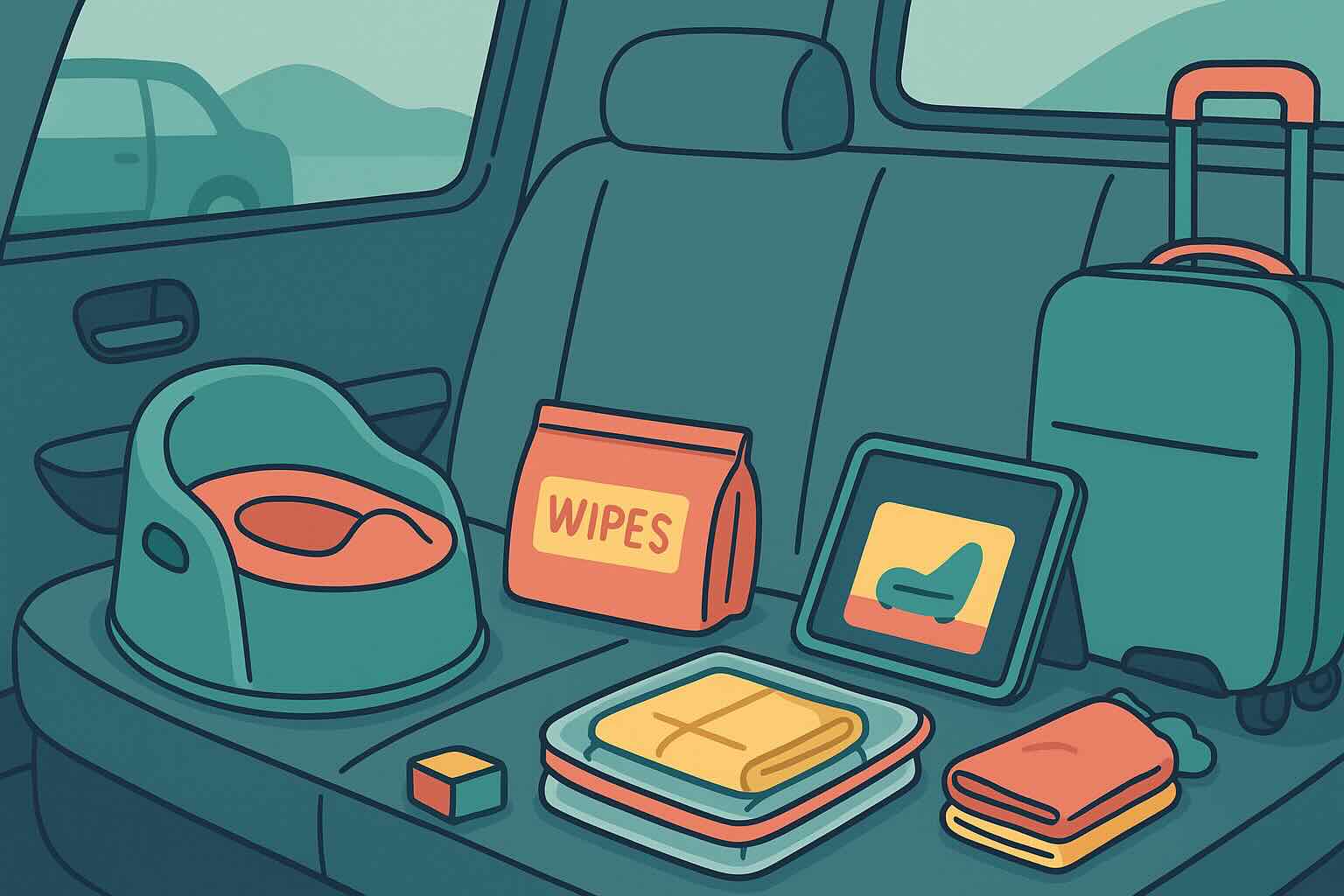
"We have a beach vacation planned in 3 weeks. My son just started using the potty consistently last week. Should I keep going with training, or put him back in diapers for the trip? I'm terrified of dealing with accidents in the car, at the beach, and in our rental house!"
This is one of the most common potty training dilemmas: you're making progress, travel is approaching, and you're not sure whether maintaining the routine or pausing will create more stress.
Here's the truth: There's no one-size-fits-all answer. The right choice depends on where you are in the potty learning journey, the type of travel you're doing, and your own stress capacity.
But here's what you need to know: Pausing temporarily is not "failing" or "going backward." Pull-ups during travel don't erase all your progress. Sometimes, reducing stress for everyone IS the right choice.
In this guide, you'll learn:
- The decision framework: pause vs. continue vs. hybrid approach
- Essential travel gear for every potty training scenario
- Public restroom strategies that reduce fear and stress
- Car trip, airplane, and long-distance travel solutions
- How to re-establish routine after returning home
Let's start with the most important question: should you pause or continue?
The Decision Framework: Pause, Continue, or Hybrid?
Ask yourself these questions to determine your best approach:
Question 1: How Long Has Your Child Been Successful?
0-4 weeks of active potty use: → RECOMMEND: Pause or use hybrid approach
Why: Skill is newly developing, not yet solidified. Travel disruption will likely cause regression that requires re-training when you return. Better to use pull-ups during travel and restart fresh when home.
2-4 months of consistent success: → OPTION: Continue with preparation
Why: Skill is more established. Child may maintain progress with support, though expect more accidents than normal.
4+ months of reliable independence: → OPTION: Continue confidently
Why: Skill is solid. Travel will still increase accidents, but progress won't be lost.
Question 2: How Long Is Your Trip?
Weekend (2-3 days): → Continue (manageable timeframe)
Week-long (5-7 days): → Hybrid approach often works best (pull-ups for specific situations, potty for others)
Extended (10+ days): → Consider pausing unless child is very established in skill
Question 3: What's Your Bathroom Access?
Good access (staying at house/hotel with bathroom, visiting family-friendly locations): → Continue possible
Limited access (camping, remote areas, all-day outdoor activities, long flights): → Pause or hybrid recommended
Question 4: What's YOUR Stress Level?
Already stressed about travel logistics: → Pause (adding potty stress isn't worth it)
Feeling capable and prepared: → Continue or hybrid
Honestly assess: Dealing with multiple accidents in unfamiliar places while managing other travel stress may feel overwhelming. Pull-ups remove one source of stress—and that's okay.
The Hybrid Approach (Often Best for Travel)
Use pull-ups/diapers for:
- Long car rides (2+ hours)
- Airplane flights
- Outings with limited bathroom access (beach, zoo, amusement parks)
- Nighttime/naps
Use potty for:
- At hotel/house when bathroom is accessible
- Short local outings where you know bathroom locations
- Mealtimes (after eating, body often signals)
Frame this for your child:
"Travel is different from home. You can use the potty when we find bathrooms, or you can use your pull-up if that feels easier or we're in the car. You decide!"
This maintains potty awareness while removing pressure and accidents stress.
For more on managing transitions, see our routine changes guide.
Essential Travel Gear: What to Pack
Must-Haves (Don't Leave Home Without These)
1. Portable potty seat
- Foldable seat that fits on any toilet
- Makes unfamiliar toilets feel safe and prevents falling-in fear
- Recommendation: OXO Tot Travel Potty Seat (folds flat, has carrying case)
2. Multiple complete spare outfits
- Pack 4-6 full changes (underwear, pants, shirt, socks)
- Double your normal supply—accidents increase during travel
3. Gallon ziplock bags
- For wet/soiled clothes (contains smell and moisture)
- Pack 6-10 bags
4. Disposable changing pads
- Protect car seats, hotel beds, public changing tables
- Also serve as emergency pee pads
5. Wipes and hand sanitizer
- Essential for limited bathroom access
- Clean hands when soap/water unavailable
6. Pull-ups (even if not using at home)
- Backup for emergencies or hybrid approach
- Pack enough for entire trip duration
Highly Recommended (Worth the Space)
7. Portable potty (like Potette Plus)
- Collapsible potty that sits on ground
- For true emergencies when no bathroom available (traffic jam, remote hike)
- Use with disposable liners or bring plastic bags
8. Waterproof car seat protector
- Essential for road trips
- Protects car seat from accidents
9. Comfort item
- Favorite potty book or small toy
- Brings familiarity to unfamiliar bathrooms
10. Night light
- For hotel/rental bathroom
- Helps child find bathroom at night in new place
Public Restroom Strategies: Reducing Fear and Increasing Success
The challenge: Public restrooms are big, loud, unfamiliar, and sometimes scary. Your newly potty-trained child may refuse to use them.
Before Entering Bathrooms
1. Scout location immediately
Upon arrival anywhere (restaurant, museum, park):
"First, let's find where the bathroom is, so you know where it is if you need it later."
Show them the door, walk them to it. Reduces panic when they need to go urgently.
2. Frequent preemptive trips
Don't wait for child to ask. Every 60-90 minutes:
"Let's check if your body needs the potty before we start the next activity."
3. Use bathroom yourself
If child hesitates:
"I'm going to use the bathroom. Want to try while we're here?"
Modeling reduces fear.
Inside Public Restrooms
1. Bring portable potty seat
Makes giant toilet feel safer and familiar.
2. Hold them securely
If no seat available:
- Stand in front of them
- Hold hands under their arms or around waist
- Provide stable support so they don't fear falling
3. Wipe seat first (visibly)
Child sees you creating a clean, safe space for them.
4. Manage loud sounds
- Auto-flush toilets terrify many children
- Cover sensor with post-it note or hand
- Flush AFTER child stands up and is a few steps away
- Explain: "Toilets make loud sounds sometimes. You're safe."
5. Validate concerns
"New bathrooms can feel weird. They look different, but your body works the same way here."
For Children Who Refuse Public Restrooms
Option 1: Portable potty in car
- Park nearby, use potty in car (pulled over safely)
- Privacy and familiarity
Option 2: Find "nicer" bathrooms
- Hotel lobbies often have quieter, cleaner bathrooms
- Some children accept those when they refuse gas station restrooms
Option 3: Hybrid approach
- Pull-up for outings, potty at hotel/house
Car Trip Solutions: Maintaining Progress on the Road
Planning Your Route
1. Map bathrooms
- Rest areas every 60-90 minutes
- Know locations before you need them urgently
2. Build in potty stops
- Add 30-45 minutes to total drive time
- Frequent stops reduce accidents and stress
3. Depart after successful potty use
- Last chance before getting in car
Car Setup
1. Waterproof protection
- Car seat protector (non-negotiable)
- Layer disposable pad on top for easy changes
2. Accessible supplies
- Spare outfit in front seat or door pocket (not trunk)
- Wipes within reach
- Ziplock bags readily available
3. Portable potty in car
- Some children can use portable potty in parked car
- Faster than finding bathroom at rest area
- Only works if child is comfortable (don't force)
During the Drive
Announce stops:
"Next bathroom stop is in 20 minutes. If your body needs to go sooner, let me know and we'll pull over."
Encourage trying at every stop: Even if they say they don't need to:
"Let's try anyway while we're here. Sometimes our bodies need to go even when we don't feel it yet."
Limit drinks moderately:
- Reduce intake 30 min before departure
- NOT total restriction (they still need hydration)
Bring engaging activities:
- Boredom leads to lots of "I need to go!" false alarms
- Books, audiobooks, quiet games
When Accidents Happen in the Car
1. Stay calm
- Pull over safely
- Take deep breath before responding
2. Matter-of-fact cleanup:
"Pee came out while we were driving. No big deal. Let's get you changed."
3. Involve child:
- "Can you help me get the clean clothes?"
- Age-appropriate participation
4. Continue trip:
- No lecture, no lingering frustration
- Return to normal energy
Airplane and Long-Distance Travel Strategies
Airplanes present unique challenges: tiny bathrooms, seatbelt sign restrictions, turbulence, unfamiliar environment.
Before the Flight
Decision point:
- First 2-3 months of potty training: Strongly recommend pull-ups for flight
- Well-established skill (4+ months): Can try maintaining potty use
Pre-flight preparation:
- Use airport bathroom immediately before boarding (last familiar toilet)
- Explain seatbelt sign: "When the light is on, everyone stays seated"
- Pack portable seat, 2-3 outfits, wipes in carry-on
During the Flight
Seating:
- Request aisle seat (essential for bathroom access)
Bathroom familiarity:
- Take child to bathroom during early boarding
- Let them see it when empty/less intimidating
Frequent trips:
- Don't wait for child to ask
- Take them every 30-45 minutes when seatbelt sign is off
Managing small space:
- Go in with child (they cannot manage alone)
- Face them backward (toward door) for easier positioning
- Hold securely during turbulence
- Bring comfort item to hold while sitting
If accident occurs:
- Clean up in bathroom quickly
- Ziplock for wet clothes
- Wipe seat with wipes
- Stay calm—happens to many families
After Travel: Re-Establishing Routine
Expect temporary regression:
- More accidents for 3-7 days after returning home
- Normal adjustment back to routine
How to re-establish:
Day 1-2 home:
- Return to previous routine (same potty, same schedule, same language)
- Increase reminders temporarily
- Stay patient and matter-of-fact about accidents
Day 3-7:
- Gradually reduce reminders as child re-adjusts
- Most children return to pre-travel baseline within a week
If using pull-ups during travel:
"We're home now! Back to using the potty like before. Your body remembers what to do."
Don't restart from zero—just resume where you were before travel.
The Bottom Line on Potty Training While Traveling
Travel during potty training doesn't have to be a disaster—but it does require realistic expectations and flexibility.
Key principles:
1. There's no "right" answer
- Pause, continue, or hybrid—all are valid based on your situation
2. Pull-ups during travel aren't failure
- You're making a strategic decision to reduce stress
- Progress isn't erased—you'll resume when home
3. Accidents increase during travel
- Even for well-established skills
- New environments, disrupted routines, excitement all contribute
4. Prepare thoroughly
- Gear, bathroom scouting, frequent stops
- Preparation reduces panic
5. Return home and resume
- Temporary travel regression resolves quickly
- Trust the skills your child developed
Your job isn't to maintain perfect potty training through every life disruption.
Your job is to make decisions that support your child's development while maintaining your own sanity and enjoyment of family experiences.
Sometimes that means full potty training through travel. Sometimes it means pull-ups for the trip. Sometimes it's a mix.
All of those choices are okay.
Because the goal isn't perfection. The goal is progress—and progress includes flexibility, adaptation, and realistic expectations during the messy, beautiful, imperfect journey of life with young children.
Related Resources
- Potty Learning Complete Guide - Comprehensive overview of the entire potty learning journey
- Potty Training Accidents Guide - Managing travel-related accidents
- 2 Year Old Potty Training Guide - Timing travel with early learning
- 3 Year Old Potty Training Guide - Travel during active training
- Nighttime Potty Training Guide - Handling nighttime while traveling
- Potty Training Regression Guide - Preventing post-travel regression
Complete Potty Learning Toolkit
Readiness assessments, age-specific strategies, and practical scripts to support your child's potty learning journey.
Need personalized support?
RootWise's AI coach can provide tailored strategies for your specific situation, available 24/7 when you need it most.
Learn More About AI Coaching →